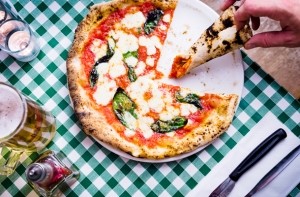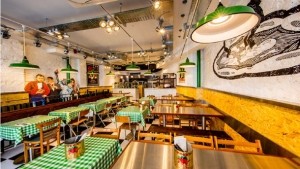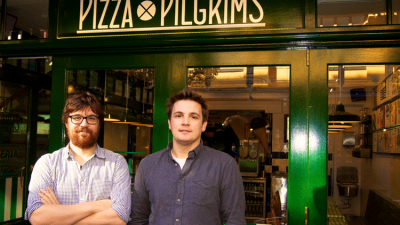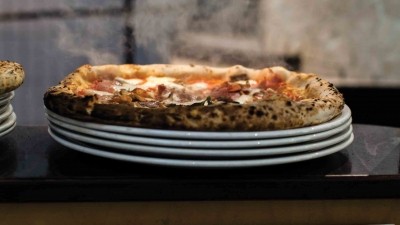Business Profile: Pizza Pilgrims
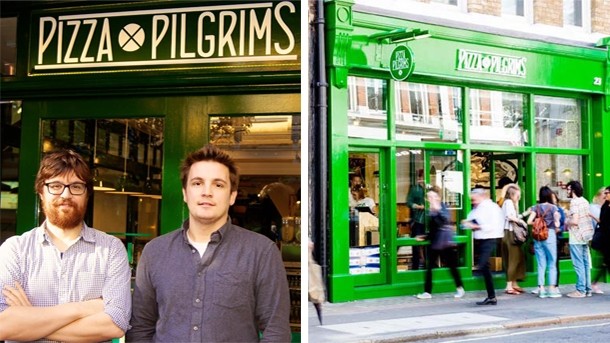
Roll out with soul is how brothers James and Thom Elliot describe their tactic for the future growth of Pizza Pilgrims, the lively London-based restaurant business they founded in 2012. With four sites proper, plus a presence in crazy golf and food venue Swingers and a pizza van, they haven’t exactly been dragging their feet with expansion thus far but the challenge, they say, is to retain the ethos of the business as the site numbers swell.
It’s a conundrum faced by many a burgeoning restaurateur and one that proves difficult to solve. How does a business, in this case born on the streets as a pizza van, remain true to its roots while simultaneously dealing with the inevitable growing pains? There’s the need for improved back office operations, staff management and retention on a wider scale, increased scrutiny of profit and margins and, the one that often proves hardest of all, delegation.
The Pizza Pilgrims way
If anyone can do it then the Elliots can. The brothers have made fun a key pillar of their restaurant model so far, with an emphasis on good music and creating a party atmosphere at each restaurant, and they don’t intend to let up on this any time soon.
Both in their thirties – Thom is 32, James 30 – they not only have the exuberance of youth on their side, but are also of a generation tired of the cookie-cutter approach to restaurants that has become a norm of the industry. Their creative backgrounds – before setting up Pizza Pilgrims James worked in TV production and Thom in advertising – have also played a part in them wanting their pizzerias to have some flair.
Yet perhaps the main driver for wanting to retain the spirit of the business as it grows is down to the rather haphazard way it was formed and subsequently run in the early days, something which endeared the brothers to their pizza-loving customers.
Like all genuinely brilliant ideas, Pizza Pilgrims was dreamt up in the pub after five pints. Thom actually quit his job the following day, despite the pair being six months away from forming the business, meaning that he had to hurriedly find another one.
“It was a case of ‘fuck you Sky TV, I don’t need you any more’,” he says, “followed by the realisation that we didn’t even have a pizza van yet. So I had to get another advertising job, working for Stannah Stairlifts.”
The pair toyed with the idea of importing pizza ovens but settled on buying a van with the aim of catering at weddings and birthday parties. Knowing little of Italian food, they went to the country, visiting restaurants and growers in Calabria, Campania, Tuscany, Piedmont and Emilia-Romagna.
Back in the UK they bought a Piaggio Ape van on a credit card, which they converted into a pizza oven, and set up a street food stall at a car park in Peckham, where a certain Yianni Papoutsis was gaining a reputation for the burgers sold out of his MEATwagon, and it snowballed from there.
“It all started out as a bit of a bet, there was no real risk factor,” says James. “Our attitude in the first three years was if it didn’t work we could go back to our normal jobs. It was all a bit temporary.”
Realising a more permanent pitch was required, they hooked up with Italian supper club Forza Win slinging pizzas from a Shoreditch rooftop, and also from a stall in Soho’s Berwick Street Market.
As a street food stall and roving pizza van, Pizza Pilgrims was an instant success.
The brothers were at the vanguard of the trend for more authentic Neapolitan pizzas and their youth and playful attitude made them a hit among the young foodie crowd. Although the van was generating money, for the first 18 months the brothers paid themselves just £100 a week in order to save for something more permanent. This money, coupled with some outside investment, gave them enough funds to open their first restaurant in 2013, in Soho’s Dean Street – directly opposite a PizzaExpress.
Making dough
In hindsight, the growth of Pizza Pilgrims seems inevitable. With a high margin product at its core it is a viable business to roll out, and with demand rising in the capital for better quality pizzas than those found in the high-street chains, having just one site would have been a wasted opportunity.
And yet the brothers insist that growth was never at the forefront of their minds in the early days, an attitude that made their approach very appealing to the outsider. “At Dean Street, I was the head chef and Thom was the manager for the first nine months. We hadn’t looked past that,” says James.
Their somewhat devil-may-care approach to business didn’t fit with a genuinely scalable concept, with the pair making many mistakes from the beginning. They may have had a bricks and mortar site, but they were running it in the kind of disorganised way the street food stall operated – “on cable ties, gaffer tape and goodwill”.
They initially opened Dean Street on £80,000, but had to close for two weeks to reconfigure it, spending another £100,000 in the process. “We’ve made mistakes a hundred times and it’s taken people to say ‘we’ve been here before let’s not do it again’,” admits James. “It hasn’t been plain sailing.”
Mistakes include buying six fridges from a man who popped his head through the restaurant door at 1am. “They all broke within 10 days. We carried 14 fridges up and down the stairs. We’ve learnt the hard way that walk-in fridges rock.”
A refrigeration breakdown on one of the hottest days of the year led to problems with the pizza dough that coincided with a visit to the restaurant by Time Out. The resulting review unfavourably compared their pizza to naan bread (the review has since been updated in acknowledgement that the restaurant can actually make decent pizza).
And then there was the episode with the street food stall when the brothers decided to ‘revolutionise the queue’ to speed things up. “Rather than have one long queue we thought we should have a separate queue for each of the pizzas to actively manage how many we needed to do,” recalls Tom.
“It was genius on paper. Within 40 minutes it was a shit show. There have been so many examples of where we’ve implemented an idea and in an hour it’s been apparent it’s not going to work. But if you start a restaurant with the team and culture at the front and centre it buys you enough goodwill to sort your shit out.”
Have-a-go generation
The early days may have seen the brothers winging it, but four and a half years into business they can no longer hide behind the facade of ignorance.
“We’ve always been the muppets of the industry, probably because we’re part of the have-a-go generation,” says James.
“But we’re at a bit of a turning point. There’s this idea that we have no experience of anything but, over time, we have cut our teeth. If it takes 10,000 hours to become an expert I think I’m already three times that.”
One only needs to look beyond the brothers’ goofball image to see that they are savvy operators. Pizza Pilgrims’ slick website – a throwback to their creative pasts – early book deal and use of online videos to promote themselves has reinforced their fun-loving image, which is as potent today as ever, and given them a cult following. More recently, they have moved into the world of retail with their frying pan pizza kit, containing the ingredients to make two margherita pizzas, which is available through Amazon.
“It’s not just our little toy any more,” adds Thom. “We realised that we employ 120 people and that we need to make sure we are doing the best for everyone in the company. Having great people in the business who really do know what they are doing has forced us to up our game. We’ve always been a ‘yes’ company – anything that comes our way we agree to and then figure out how to do it later, but there was a point where we took on too much and did things half-heartedly. We can’t afford to do that any more.”
Taking on Kingly Court for their second site was an example of them not being able to say no, despite their reservations over it. The brothers took a lot of convincing by landlord Shaftesbury, which wanted a pizzeria to add to the mix of restaurants it was putting into the new food court development just off Carnaby Street. It had initially approached pizza rival Homeslice but after getting a rebuttal it turned to its next preferred pizza player.
Moving into Kingly Court proved a masterstroke. On arguably the development’s best site, with access on Kingly Street and Kingly Court, on a busy day the restaurant can do 1,200 pizzas.
Autonomy rules
The draw of rent-free periods and being courted by large London landlords means that Pizza Pilgrims has taken the path trodden by many nascent restaurant businesses in terms of expansion. So back to the brothers’ attempt to ‘roll out with soul’ – how do they believe they can do this while all the time having a carrot dangled by outside influences?
Their answer, they say, it to take the lead from other businesses, but not from the world of restaurants. Instead, the pair intend to follow the model taken by shoecare and key cutting business Timpson after having met its chairman and been inspired by the company’s philosophy.
“Timpson has around 1,200 shops and they all run independently. There’s no central EPoS and there are three people in every shop. They set their own prices and can spend up to £500 to rectify a customer complaint without going to a manager. It’s called upside-down management, and we loved that,” says Thom.
Staff at Pizza Pilgrims are given a lot of autonomy over how the restaurants are run. Everyone in the company is now promoted from within, creating a close knit community. “It’s looking at things and thinking ‘is that absolutely necessary or is it just what the last company I worked for did?’, says James.
Changes have been made to the operation since the early days. The brothers initially intended to introduce slight tweaks to each new restaurant to give them personality – Kingly Court has a ‘friggitoria’ (from the fryer) section on the menu – but quickly realised this created unnecessary work for them. “We started out trying to rewrite the rule book every time but now we are just playing the hits,” says Thom.
The restaurants have the same menus, with a range of 10 pizzas, and the pricing structure means that customers can come in and have a margherita and a beer for £10. Where the differences lie is how each location is used. At Exmouth Market, for example, average spend per head is double that at Kingly Court and customers dwell longer as they see it more as a neighbourhood restaurant.
“Pizza is a universal food,” says James. “It can be a romantic dinner for two with a bottle of barolo as at Exmouth Market or a 20-minute bite to eat with a Coke at Kingly.”
The pair also had the fanciful notion in the early days that each restaurant should be run like a house party, with the chefs encouraged not to worry about the numbers. “We got that completely wrong,” admits James. “We realised that people want to be invested and know more about the business. To not have them involved in the financials only gives them half a job.”
As from this month, the company is introducing special dishes for each site, with chefs required to look at GP when creating them, although the brothers are determined not to let accountancy inform creativity. “I’d much prefer a chef makes a mega truffle pizza which he charges £4 for and we then call him out on it after two weeks than have the stance that they have to hit this GP or don’t bother,” says Thom.
“It is much more interesting to give people free rein. We give them to tools to calculate GP but encourage them to tell us if they want to do something different.”
The pair made the decision early on to never centralise its kitchen, something which they believe would kill the operation. “There is an eternal struggle among chefs to find the perfect pizza,” says James. “If you took dough making away from them you would take a big part of their job away.”
The brothers’ street food background also means they haven’t been afraid to muck in with all aspects of the business.
“A lot of companies of our size have no interest in numbers and farm things out for other people to deal with,” says Thom. “That’s a dangerous thing. If you don’t understand every element of your business to some level you can never make it better or understand what the people doing it are going through. We’ve probably stretched ourselves too thin and made more mistakes as a result, but I can put my hand up and say there is nothing in the business I’ve not done.”
Fun times ahead
So how does this approach translate into future growth? Pizza Pilgrims’ recent openings have shown that the brothers are not afraid to take on interesting sites.
Their latest restaurant, on Garrick Street in London’s Covent Garden, sits on the former site of Sesame, the ill-fated Middle Eastern café that closed within six months of launch. The high-spec fit-out that the Sesame team undertook, however, meant that converting it to a pizzeria was relatively simple.
Meanwhile, their other new project, in crazy golf venue Swingers, located at the foot of the Gherkin, has kept the youthful feel of the business alive. Here Pizza Pilgrims has a counter on a three-year lease (with a first refusal to extend) and pays a percentage of earnings plus a small capex contribution. The waiting staff are employed by the operator, which might seem simple, but it has meant that the brothers have had to build in a bonus scheme for its chefs to compensate for the fact that they don’t get a share of tips as in the other sites.
Their next venture, in West India Quay, takes the fun element of Swingers and runs with it. At 5,500sq ft, you could fit the company’s existing restaurant estate into the building, which the pair want to turn into a ‘pizza playground’.
With space for 250 covers, the intention is to create a 150-cover pizzeria and use the remainder of the space for entertainment, with the inclusion of the UK’s longest fussball table and an area with sofas where customers can sit and play computer games. They also intend to install a bocci ball court, where customers can try their hand at the Italian version of boules.
“On any business plan, this would raise eyebrows, but it is really fun and different,” says Thom. “We haven’t gone ‘this is what a Pizza Pilgrims looks like so let’s do 50 of them’, but rather thought ‘that looks fun and might work, let’s do it’.
The pair can take this approach because they are not answerable to any major shareholders. While Pizza Pilgrims does have investors, there is a wide pool of them so “no one is breathing down our necks,” says Thom. Growth has so far been through cash flow, except for Garrick Street, for which a bank loan was taken out. “Every decision is ours. No one says we need to do this or that. We wouldn’t give that up that in order to hit growth targets.”
As for growth beyond West India Quay, an opening date for which hasn’t been set, the brothers are looking outside of central London. “The classic street food approach would be to find a deserted warehouse that attracts hipsters, but I don’t buy that any more,” says James.
“The Rib Man opening in Euston station is what street food should be doing; bringing people great food at the right price. We want to go wherever people will buy our pizzas.”
Places earmarked include Peckham and Brixton and also east London, where they get regular customer requests to open. The pair has even taken on a property director for the first time to help with site selection. “We want to be able to fit into small awkward spaces and not pay massive premiums for big glass boxes. The whole world is looking for 3,000sq ft, ground floor sites with three-phase electric, but that dream is so expensive you can’t make it stack up,” says James.
Wherever they go next, their challenge will be whether they really can roll out with soul. Or as Thom says: “We’ve been pushing a snowball up a hill until now and we’re now at the point where we’re over the hill. Our job now is to keep it the right shape as it goes down.”
